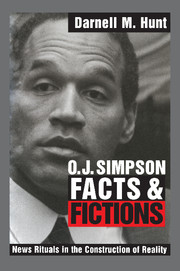Book contents
- Frontmatter
- Contents
- List of figures
- List of tables
- Acknowledgments
- Introduction: Knowing O.J.
- Part I Theory
- 1 O.J. and ritual
- 2 O.J. and politics
- Part II News construction
- Part III Audience reception
- Part IV Conclusions
- Appendix 1 Page-one narratives, Los Angeles Times, January 25–October 4, 1995
- Appendix 2 Page-one O.J. narratives, Los Angeles Sentinel, January 25–October 5, 1995
- Appendix 3 Emerging discussion themes, by group, March 30, 1995
- Appendix 4 Emerging discussion themes, by group, August 1, 1995
- Appendix 5 Transcript of Primetime text
- Appendix 6 Transcript of KTLA text
- Appendix 7 Logistic regression of perceptions about Simpson's innocence or guilt on race, gender, education, family income, interviewer race, and perceptions of criminal justice system bias
- Notes
- References
- Index
1 - O.J. and ritual
Published online by Cambridge University Press: 22 September 2009
- Frontmatter
- Contents
- List of figures
- List of tables
- Acknowledgments
- Introduction: Knowing O.J.
- Part I Theory
- 1 O.J. and ritual
- 2 O.J. and politics
- Part II News construction
- Part III Audience reception
- Part IV Conclusions
- Appendix 1 Page-one narratives, Los Angeles Times, January 25–October 4, 1995
- Appendix 2 Page-one O.J. narratives, Los Angeles Sentinel, January 25–October 5, 1995
- Appendix 3 Emerging discussion themes, by group, March 30, 1995
- Appendix 4 Emerging discussion themes, by group, August 1, 1995
- Appendix 5 Transcript of Primetime text
- Appendix 6 Transcript of KTLA text
- Appendix 7 Logistic regression of perceptions about Simpson's innocence or guilt on race, gender, education, family income, interviewer race, and perceptions of criminal justice system bias
- Notes
- References
- Index
Summary
News reading, and writing, is a ritual act and moreover a dramatic one. What is arrayed before the reader is not pure information but a portrayal of contending forces in the world.
(Carey 1975, p. 8)During the early morning hours of June 13, 1994, two slashed and mangled bodies – a white woman and man – were discovered lying in pools of their own blood in Los Angeles' fashionable Brentwood district. Shortly thereafter, electronic networks around the world were buzzing with news of the murders of Nicole Brown-Simpson and Ronald Goldman, of evidence pointing toward the guilt of black football legend Orenthal James Simpson. But Simpson's attorneys steadfastly proclaimed his innocence.
Then, on June 17, a Los Angeles Police Department commander made a shocking announcement to the media: the prime suspect had failed to turn himself in to police as promised. An audible gasp filled the press room. Hours later, Simpson was spotted south of Los Angeles, on the Interstate 5, in the back of a white Ford Bronco. News of the development quickly circulated throughout society. Ninety-five million viewers across the nation – one of the largest television audiences in US history – watched helicopter video images of Simpson and friend A. C. Cowlings slowly leading a growing contingent of law enforcement vehicles back up the freeway. NBC postponed its coverage of the New York Knicks championship basketball game.
- Type
- Chapter
- Information
- O. J. Simpson Facts and FictionsNews Rituals in the Construction of Reality, pp. 17 - 48Publisher: Cambridge University PressPrint publication year: 1999

